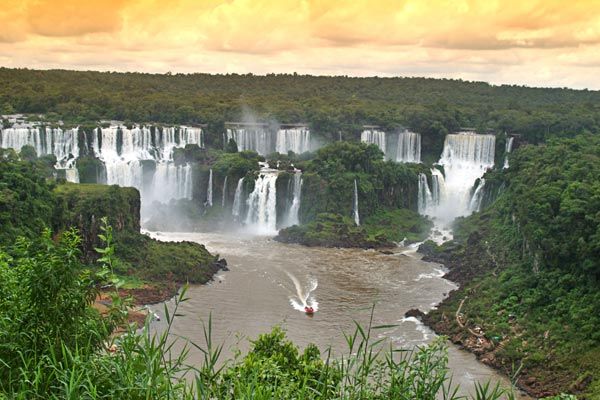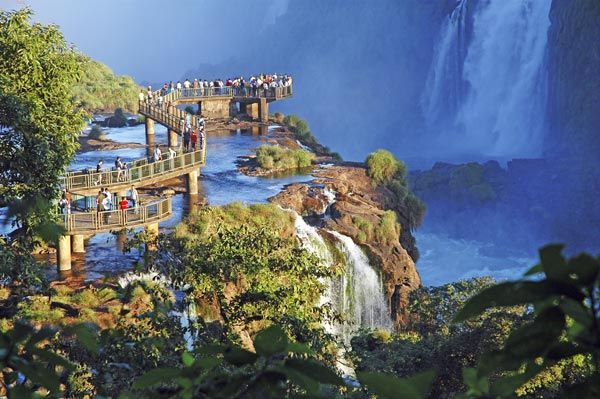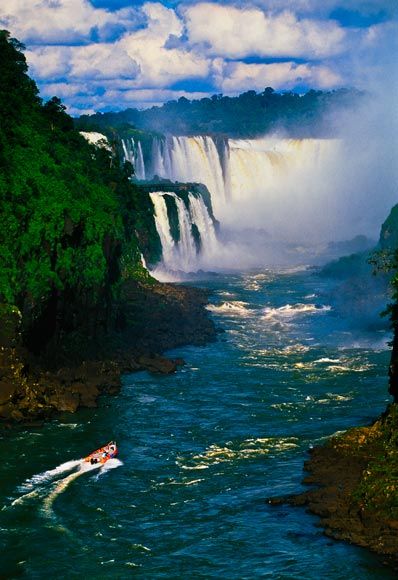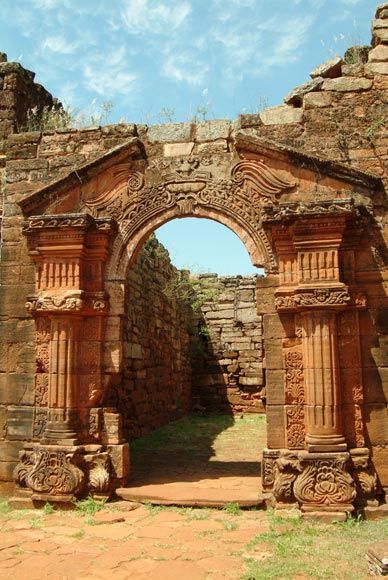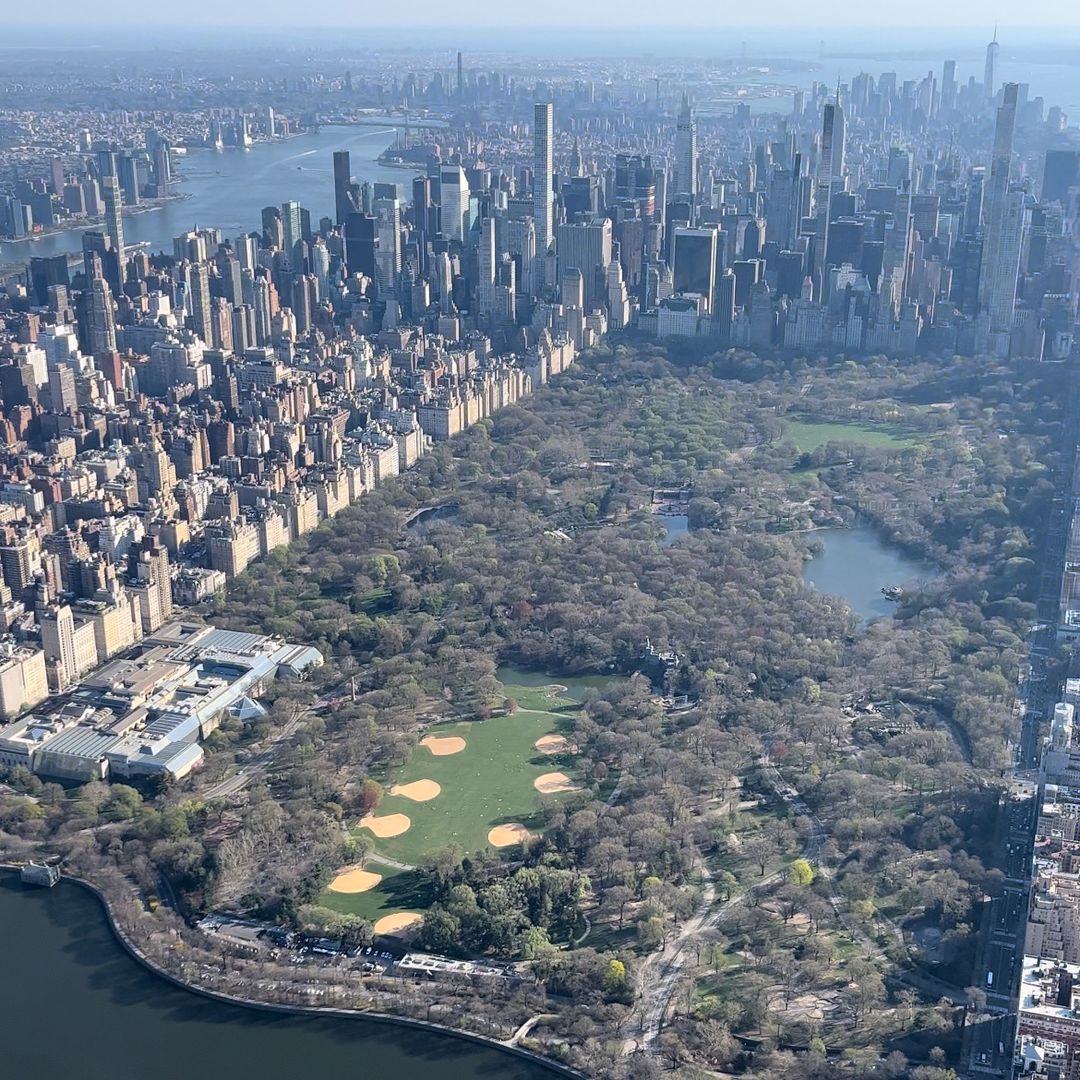As the widest series of waterfalls in the world, Iguazu Falls is one of the seven natural wonders. It offers one of the most awe-inspiring sights in nature, its widest fall stretching out across more than 1.9 miles. Iguazu Falls are unique and a sight worth seeing at least once in a lifetime, beyond compare with Niagra falls at four times the width of Niagara's main fall, and almost twice its height.
The Iguazu River is the main contributory to the Falls. Measuring only 435 miles long, it is relatively small compared to most rivers in South America. Born in the coastal mountains of Brazil, a mere 31 miles from the ocean, it runs west through the south of the country and has almost no current. A few miles before reaching the falls, it widens, divides into two main channels and then falls from a vast height.
Legend has it that a god planned to marry a beautiful woman named Naipí, who fled with her mortal lover Tarobá in a canoe. In a rage the god sliced the river, creating the waterfalls andcondemning the lovers to an eternal fall.
The Garganta Del Diablo is an immense horseshoe-shaped cliff where the power and forces of nature seems to come together, making the biggest fall. The Argentinian waters running into the river and accumulating at this point takes its time to arrive. First it coils around two islands and then falls into one of the many cascades on that side. The most important ones are: Floriano; Union; Rivadavia; Belgrano; Los Tres Mosqueteros; San Martín; and Bossetti. Each one is enormous and has a drop of no less than a whopping 197ft. During the rainy season, you can hardly tell where one fall starts and the other begins due to the sheer volume of water. After passing through the Iguazu Falls, the river continues through a steep valley for 12.5 miles and then joins the Parana River.
The Caigangue tribe , who inhabited the area when the first Europeans arrived, called the Garganta Del Diablo Fall, is a "place where clouds are born".
When the water hits the bottom of the cascade, the force is so powerful that it pulverizes the water and forms a cloud of spray that rises high into the air. This mist then falls gently over the whole area. It cools you as you walk down the paths and see it in the humidity of the red limestone that surrounds the area.
The vegetation surrounding the Iguazu Falls consists mainly of bamboo, precious orchids that completely cover the steep cliff sides where there is no water, and hundreds of species of tropical trees. The lush ground is adorned with ferns and moss. The forest that surrounds the Falls is divided into two national parks and protects almost 1,553 miles of tropical and subtropical ecosystems. It is one of the richest and most complex in the world. You can find orchids growing next to pine forests, and bamboo next to palm trees. In this environment, wildlife abounds. In its lush shade, jaguars, deer, tapir and ocelot all roam about freely, along with an immense variety of smaller animals.
The Argentine side is located in the province of Misiones. A road runs through the territory and leads to the ruins of the 13 Spanish missions which were built and founded in the region. San Ignacio Mini is the one that has been best conserved, and the layout is very similar to the rest: a central square with a church, cemetery, main houses and Town Hall surrounding it. These ruins, along with the Argentinian missions Nuestra Señora de Loreta and Santa María la Mayor, and the Brazilian site Sao Miguel, were declared World Heritage sites by UNESCO in 1984. The missions of Santísima Trinidad and Jesus, in Paraguay, were also declared World Heritage in 1993. All of them are a reflection of a historic moment which the Iguazu Falls have witnessed in their eternal presence.
PRACTICAL GUIDE
How to get there
There are daily flights from Gatwick and Heathrow to Sao Paulo and Buenos Aires, from where you can catch a connecting flight to the Falls. There is a smaller national airport in Puerto Iguazu, on the Argentine side, and another one in Foz de Iguazu, on the Brazilian side.
When to go
This exquisite site is beautiful any time of year, but the best season to visit the Falls is between July and September, when the temperatures in Misiones are a lot milder than during the rest of the year.
Where to go
The best views are usually found on the Brazilian side looking across at the waterfalls in Argentina. Therefore we recommend you start your visit in Brazil and then cross the border for a closer look at each fall. On the Brazilian side there are many paths with great panoramic stopping points and an elevator that takes you to the top of the Salto Floriano Fall. The guided excursions are a must, and there is also a museum near the entrance worth a visit. On the Argentine side, there are four hour guided excursions throughout the day and also night visits if you are lucky enough to land a moonlit evening. There are also boat trips on both sides of the border. At the foot of the Falls, you can follow an elevated man-made path, which is perfectly safe even without a guide, but you will definitely need a raincoat! There is a bus service that goes to Puerto Canoas to visit the Garganta Del Diablo.
Where to sleep
The Sheraton Iguazu Resort - on the Argentine side - and the Hotel das Cataratas - on the Brazilian side - are the two luxurious options that are both within the park. But most visitors prefer to stay in Puerto Iguazu of Foz do Iguazu and take early buses to the falls.
Where to eat
Fortín Cataratas is very near the park and serves a great Argentine barbecue. In downtown Puerto Iguazu there are two highly-recommended spots:
El Quincho del Tío Querido and La Rueda, where the fish is served fresh from the local clear rivers.
More information
In Argentina, the Cataratas de Iguazu tourist office; in Brazil, the Iguazu tourism office and the Brazilian tourism office.

